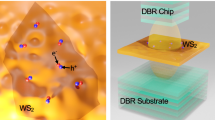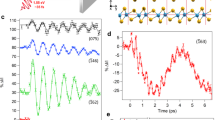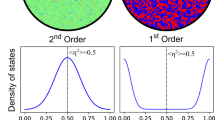Abstract
Control of the optical properties of matter on ultrashort timescales is of both fundamental interest and central importance for applications in photonics. It is desirable to achieve pronounced changes over a broad spectral range using the least possible amount of material. Here, we demonstrate a dramatic change over a spectral range of hundreds of meV on the femtosecond timescale in the optical response of atomically thin two-dimensional crystals of the transition-metal dichalcogenide WS2 following excitation by intense optical pump pulses. Our findings reveal the role of extremely strong Coulomb interactions. At the direct gap, we observe a Mott transition from excitonic states to free carriers, accompanied by a giant bandgap renormalization of approximately 500 meV and the development of population inversion.
This is a preview of subscription content, access via your institution
Access options
Subscribe to this journal
Receive 12 print issues and online access
$209.00 per year
only $17.42 per issue
Buy this article
- Purchase on Springer Link
- Instant access to full article PDF
Prices may be subject to local taxes which are calculated during checkout




Similar content being viewed by others
References
Klingshirn, C. & Haug, H. Optical properties of highly excited direct gap semiconductors. Phys. Rep. 70, 315–398 (1981).
Moskalenko, S. A. & Snoke, D. W. Bose–Einstein Condensation of Excitons and Biexcitons (Cambridge Univ. Press, 2005).
Kasprzak, J. et al. Bose–Einstein condensation of exciton polaritons. Nature 443, 409–414 (2006).
Almand-Hunter, A. E. et al. Quantum droplets of electrons and holes. Nature 506, 471–475 (2014).
Kazimierczuk, T., Fröhlich, D., Scheel, S., Stolz, H. & Bayer, M. Giant Rydberg excitons in the copper oxide Cu2O. Nature 514, 343–347 (2014).
Klingshirn, C. Semiconductor Optics 3rd edn (Springer, 2007).
Haug, H. & Koch, S. W. Quantum Theory of the Optical and Electronic Properties of Semiconductors 5th edn (World Scientific, 2009).
Novoselov, K. S. et al. Two-dimensional atomic crystals. Proc. Natl Acad. Sci. USA 102, 10451–10453 (2005).
Wang, Q. H., Kalantar-Zadeh, K., Kis, A., Coleman, J. N. & Strano, M. S. Electronics and optoelectronics of two-dimensional transition metal dichalcogenides. Nature Nanotech. 7, 699–712 (2012).
Butler, S. Z. et al. Progress, challenges, and opportunities in two-dimensional materials beyond graphene. ACS Nano 7, 2898–2926 (2013).
Jariwala, D., Sangwan, V. K., Lauhon, L. J., Marks, T. J. & Hersam, M. C. Emerging device applications for semiconducting two-dimensional transition metal dichalcogenides. ACS Nano 8, 1102–1120 (2014).
Splendiani, A. et al. Emerging photoluminescence in monolayer MoS2 . Nano Lett. 10, 1271–1275 (2010).
Mak, K. F., Lee, C., Hone, J., Shan, J. & Heinz, T. F. Atomically thin MoS2: a new direct-gap semiconductor. Phys. Rev. Lett. 105, 136805 (2010).
Li, Y. et al. Measurement of the optical dielectric function of monolayer transition-metal dichalcogenides: MoS2, MoSe2, WS2, and WSe2 . Phys. Rev. B 90, 205422 (2014).
Zhang, C., Johnson, A., Hsu, C.-L., Li, L.-J. & Shih, C.-K. Direct imaging of band profile in single layer MoS2 on graphite: quasiparticle energy gap, metallic edge states, and edge band bending. Nano Lett. 14, 2443–2447 (2014).
He, K. et al. Tightly bound excitons in monolayer WSe2 . Phys. Rev. Lett. 113, 026803 (2014).
Chernikov, A. et al. Exciton binding energy and nonhydrogenic Rydberg series in monolayer WS2 . Phys. Rev. Lett. 113, 076802 (2014).
Ye, Z. et al. Probing excitonic dark states in single-layer tungsten disulphide. Nature 513, 214–218 (2014).
Ugeda, M. M. et al. Observation of giant bandgap renormalization and excitonic effects in a monolayer transition metal dichalcogenide semiconductor. Nature Mater. 13, 1091 (2014).
Steinhoff, A., Rösner, M., Jahnke, F., Wehling, T. O. & Gies, C. Influence of excited carriers on the optical and electronic properties of MoS2 . Nano Lett. 14, 3743–3748 (2014).
Korn, T., Heydrich, S., Hirmer, M., Schmutzler, J. & Schüller, C. Low-temperature photocarrier dynamics in monolayer MoS2 . Appl. Phys. Lett. 99, 102109 (2011).
Wang, R. et al. Ultrafast and spatially resolved studies of charge carriers in atomically thin molybdenum disulfide. Phys. Rev. B 86, 045406 (2012).
Shi, H. et al. Exciton dynamics in suspended monolayer and few-layer MoS2 2D crystals. ACS Nano 7, 1072–1080 (2013).
Wang, Q. et al. Valley carrier dynamics in monolayer molybdenum disulfide from helicity-resolved ultrafast pump–probe spectroscopy. ACS Nano 7, 11087–11093 (2013).
Sim, S. et al. Exciton dynamics in atomically thin MoS2: interexcitonic interaction and broadening kinetics. Phys. Rev. B 88, 075434 (2013).
Kozawa, D. et al. Photocarrier relaxation pathway in two-dimensional semiconducting transition metal dichalcogenides. Nature Commun. 5, 4543 (2014).
Mai, C. et al. Many-body effects in valleytronics: direct measurement of valley lifetimes in single-layer MoS2 . Nano Lett. 14, 202–206 (2014).
Lagarde, D. et al. Carrier and polarization dynamics in monolayer MoS2 . Phys. Rev. Lett. 112, 047401 (2014).
Singh, A. et al. Coherent electronic coupling in atomically thin MoSe2 . Phys. Rev. Lett. 112, 216804 (2014).
Kumar, N. et al. Exciton–exciton annihilation in MoSe2 monolayers. Phys. Rev. B 89, 125427 (2014).
Cui, Q., Ceballos, F., Kumar, N. & Zhao, H. Transient absorption microscopy of monolayer and bulk WSe2 . ACS Nano 8, 2970–2976 (2014).
Mouri, S. et al. Nonlinear photoluminescence in atomically thin layered WSe2 arising from diffusion-assisted exciton–exciton annihilation. Phys. Rev. B 90, 155449 (2014).
He, J. et al. Electron transfer and coupling in graphene–tungsten disulfide van der Waals heterostructures. Nature Commun. 5, 5622 (2014).
Wang, G. et al. Valley dynamics probed through charged and neutral exciton emission in monolayer WSe2 . Phys. Rev. B 90, 075413 (2014).
Sun, D. et al. Observation of rapid exciton–exciton annihilation in monolayer molybdenum disulfide. Nano Lett. 14, 5625–5629 (2014).
Chow, W. W. et al. Comparison of experimental and theoretical GaInP quantum well gain spectra. Appl. Phys. Lett. 71, 157 (1997).
Ellmers, C. et al. Measurement and calculation of gain spectra for (GaIn)As/(AlGa)As single quantum well lasers. Appl. Phys. Lett. 72, 1647 (1998).
Lange, C. et al. Transient gain spectroscopy of (GaIn)As quantum wells: experiment and microscopic analysis. Appl. Phys. Lett. 90, 251102 (2007).
Zhao, W. et al. Evolution of electronic structure in atomically thin sheets of WS2 and WSe2 . ACS Nano 7, 791–797 (2013).
Mak, K. F. et al. Measurement of the optical conductivity of graphene. Phys. Rev. Lett. 101, 196405 (2008).
Hecht, E. Optics 4th edn (Addison-Wesley, 2001).
Carvalho, A., Ribeiro, R. M. & Castro Neto, A. H. Band nesting and the optical response of two-dimensional semiconducting transition metal dichalcogenides. Phys. Rev. B 88, 115205 (2013).
Qiu, D. Y., da Jornada, F. H. & Louie, S. G. Optical spectrum of MoS2: many-body effects and diversity of exciton states. Phys. Rev. Lett. 111, 216805 (2013).
Lange, C. et al. Ultrafast nonlinear optical response of photoexcited Ge/SiGe quantum wells: evidence for a femtosecond transient population inversion. Phys. Rev. B 79, 201306 (2009).
Zhao, W. et al. Origin of indirect optical transitions in few-layer MoS2, WS2, and WSe2 . Nano Lett. 13, 5627–5634 (2013).
Acknowledgements
This work was supported by the US Department of Energy, Office of Science, Office of Basic Energy Sciences, with funding at Columbia University through the Energy Frontier Research Center under Grant DE-SC0001085 and at SLAC National Accelerator Laboratory through the AMOS programme within the Chemical Sciences, Geosciences and Biosciences Division, by the Keck Foundation, and by the Air Force Office of Scientific Research (grant no. FA9550-14-1-0268). C.R. and A.C. acknowledge partial funding from the Alexander von Humboldt Foundation within the Feodor Lynen Research Fellowship programme. H.M.H. and A.F.R. were supported, respectively, by the NSF through an IGERT Fellowship (grant no. DGE-1069240) and by a Graduate Research Fellowship (DGE-1144155).
Author information
Authors and Affiliations
Contributions
A.C. and C.R., contributing equally to this work, designed the experiment, carried out the measurements and analysed the data. H.M.H. and A.F.R. prepared and characterized the samples. A.C., C.R. and T.F.H. wrote the manuscript. All authors contributed to discussions.
Corresponding authors
Ethics declarations
Competing interests
The authors declare no competing financial interests.
Supplementary information
Supplementary information
Supplementary information (PDF 2989 kb)
Rights and permissions
About this article
Cite this article
Chernikov, A., Ruppert, C., Hill, H. et al. Population inversion and giant bandgap renormalization in atomically thin WS2 layers. Nature Photon 9, 466–470 (2015). https://doi.org/10.1038/nphoton.2015.104
Received:
Accepted:
Published:
Issue Date:
DOI: https://doi.org/10.1038/nphoton.2015.104
This article is cited by
-
Ultra-compact exciton polariton modulator based on van der Waals semiconductors
Nature Communications (2024)
-
Correlation-driven nonequilibrium exciton site transition in a WSe2/WS2 moiré supercell
Nature Communications (2024)
-
Strong coupling in plasmonic metal nanoparticles
Nano Convergence (2023)
-
Optical gain and lasing from bulk cadmium sulfide nanocrystals through bandgap renormalization
Nature Nanotechnology (2023)
-
In-gap band formation in a periodically driven charge density wave insulator
Communications Physics (2023)



